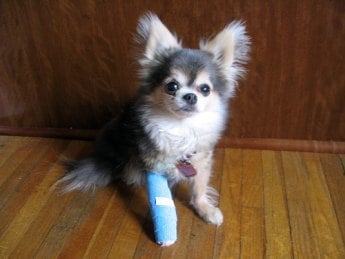BROKEN BONES – DOGS
The most common cause of broken bones in dogs is automobile accidents. Fights between big dogs and little dogs can also end up causing broken bones. Other causes include falling from a table, bouncing from the back of a pick-up truck, and various diseases, including bone cancer. Sometimes, you can tell if your dog has a broken leg if he is holding it in an abnormal position, or if it is at an unusual angle or is very swollen. Most obvious of all is an open wound with a piece of bone, sticking out. Fractures are at high risk of becoming seriously infected. The dog may let you know he’s in pain by limping or being reluctant to put his weight on the particular leg, or he might just hold the leg up and not put any weight on it at all. Your dog may not want the leg to be touched, even by you.
WHAT YOU CAN DO
* If you suspect your dog’s leg is broken, immobilizing the leg with a splint helps prevent further injuries, especially if it is a long way to the vet. To make a splint, you can use a few pieces of newspaper, cardboard, or even a soft pillow will work. Wrap them around the fracture and try to include the joint above and below the break, then secure it with tape.
* You can also just tape the bad leg to the good leg. Be careful not to tape it too tight. This is called a mountaineering splint.
* A firm surface like a piece of plywood should be used to move any dog suspected of having a broken back or who has been hit by a car. If that’s not available, put him in a blanket. The goal is to move him with a minimal amount of motion.
(NOTE: A cast is one way to repair a broken leg.)
WHAT YOUR VET CAN DO
* Your vet’s goal to repair the fracture will be to reunite the pieces, restore full function, and end up with a normal appearance to the dog.
* The diagnosis of a fracture is made by taking an x-ray of the bones. Treatment can consist of using casts, splints, plates, or wires. Casts are made of fiberglass or plaster, but their use is limited. Since the joint above and below a break must be immobilized, a cast cannot be used for fractures involving bones of the hip or shoulder. They work best for simple fractures involving the lower part of a leg.
* If a fracture is too complicated to be repaired using a cast, stainless steel pins, wires, and bone plates can be used. Intramedullary pins are steel rods inserted inside broken bones to hold the pieces of bone together. The post-operative care requires limited exercise, such as leash walking, to prevent the pins from moving. The pins are left in until the fracture heals, generally four to eight weeks, then removed under local anesthesia.
Orthopedic wire can be used to put fragments of bone together or to anchor a bone to an intramedullary pin to make the repair more stable.
Stainless steel bone plates are screwed directly into the bone. Plates and screws can be used to repair broken bones with odd shapes, like the pelvis, or badly broken long bones of the front or hind legs. Bone plates are very expensive, but minimal post-operative care is needed. These dogs can use their legs almost immediately after the surgery and are pain free.
NOTE: An intramedullary pin holds the two ends of the broken bone in place.
COMPLEMENTARY TREATMENTS
HOMEOPATHIC REMEDIES
Immediately after the injury has occurred, the use of Amica 30c not only relieves pain, but also helps reduce associated swelling. Give four doses every 15 minutes, until you can get the dog to the vet.
Symphytum 30c promotes healing of broken bones, for older dogs Calcarea fluorica 30c is often recommended as well. Talk to your vet about how often to give these therapies to your dog.
I answer all possible questions about broken bones at BrokenBoneAdvice.com.
